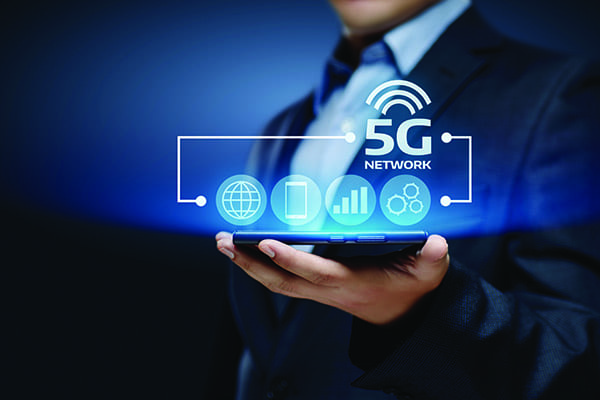Optimizing Power Plant Decisions with 5G Technology
The power industry is always looking for ways to improve efficiency and enhance reliability. 5G, that is, fifth-generation wireless technology, may help utilities reach new heights.
Every day, we learn a little more about what’s possible with 5G. While initial rollouts of 5G have positioned the technology as a successor to 4G LTE, its potential applications extend far beyond speedier smartphone technology. At the same time, as the excitement around 5G increases, it becomes difficult to separate fact from fiction and identify exactly how the new technology will enable progress in individual industries, especially for utilities.
 |
|
1. 5G is the fifth generation of wireless technology. Some testing indicates 5G may provide speeds up to 20 times faster than current-generation wireless. At least one study suggests the utility industry will be among the leading investors in 5G technology in the coming years. Source: Shutterstock |
5G is essentially a fully wireless form of digital communications that allows the seamless transmission of information from one device or entity to another—resulting in a fully connected world (Figure 1). This technology has obvious applications in the consumer entertainment space, enabling faster streaming feeds and immersive entertainment experiences such as augmented reality (AR) and virtual reality (VR), but it can also up-level the utility and industrial internet of things (IIoT) space. When paired alongside existing (and complementary) technologies, including artificial intelligence (AI), 5G can enable greater connectivity and faster analysis of industrial data.
5G should be a pillar of every organization’s roadmap. It will play a key role in infrastructure, and organizations must prepare themselves for the increased importance of this technology.
Preparing for New Technology
There’s a learning curve when implementing any kind of new technology. Between weaving in new methods and systems with the existing technology in place, and ensuring that employees are well-equipped to work with new technology, there’s a lot that needs to be done to set the stage for technologies such as 5G and AI.
The utility industry is at a unique inflection point. As an industry that has traditionally struggled to make its way into the digital era, 5G could be the push utilities need to amplify the impact of existing technologies, such as AI.
Before we discuss the benefits of 5G and other transformative technology, we have to recognize the history of the utility industry, identify the past technologies that failed to gain traction, and determine how best to avoid making those mistakes when implementing new technology moving forward.
The utility industry is cautious to adopt new forms of technology, which largely boils down to having to create change at scale. There are three main objectives that the utility industry typically focuses on: safety, reliability, and affordability. Because this industry is heavily regulated (and rightfully so)—the safety and reliability of new technology must be proven prior to implementation.
In order to sustain technological progress and create a more secure standard of care, utilities and regulators must work together to create a system that ensures utilities remain safe while enabling the exploration of new technology. While there’s no one right answer for accomplishing this, the best way to start is by pooling industry data points and use cases to share with regulators as a proof point for new technologies. This helps create an industry standard of care that pushes for a greater culture of innovation.
We’ve seen this with a number of different forms of technology, most notably with blockchain. Blockchain received acclaim and hype when it first entered the scene, but it’s making slow progress due to lack of regulations and inadequate organizational readiness, resulting in slow adaptation of technology.
Given general confusion around the nebulous nature of 5G networks, the actual effectiveness of the technology may not be immediately apparent to utilities. However, with proper preparation and education, utilities can use 5G and other rising technologies such as AI to their advantage to gain the insights that matter most in three key areas: predictive monitoring, continuous transmission of data, and quicker decision-making for digital workers.
Remove Data from Siloes
The energy grid is best described as a network of networks, or a combination of thousands of devices that work to power homes and businesses across regions (Figure 2). This creates dissonance when each data source remains siloed, though there’s great opportunity with 5G networks to connect and synthesize these data sources to create a streamlined flow of data to support monitoring and maintenance efforts.
 |
|
2. The world is more connected than ever, and the power gird is no exception. Billions of devices are constantly communicating to keep the lights on around the globe. Source: Shutterstock |
When devices are in remote locations, the data can be transmitted in real-time so those controlling can identify and remediate problems before they escalate. Sensor data captured by 5G networks allows teams to remotely send commands through devices to control operations and make changes, enabling the remote monitoring of capabilities and decisions for these devices.
Stay Ahead of the Curve with Predictive Monitoring
Utility assets receive and share massive amounts of data—with the implementation of AI, utilities can assess when machinery needs maintenance and send signals to the grid when hardware is about to fail. Rural areas and others with low connectivity are especially vulnerable to hardware failures. 5G will help enable the faster transfer of data, especially in areas with historically low connectivity. By layering AI over the pool of data, utilities can automate the diagnostic process, and anticipate when there are maintenance needs, better preparing teams and customers ahead of power outages.
Proactive monitoring is a valuable key to identifying problems before they escalate. With 5G, teams can proactively monitor infrastructure and identify the patterns that indicate whether or not the system is processing at a normal standard. By having a consistent understanding of the operational health of the network and its assets, teams can more-quickly identify when the infrastructure fails.
Work Smarter, Not Harder
A more-connected industrial system benefits human workers just as much as it benefits the bottom line. With an increase in connectivity, and access to clean, actionable data, workers will be more empowered to make real-time decisions using the data at hand. As this role becomes increasingly digitized, workers must prioritize specific skills to remain competitive.
Primarily, employees should learn to make decisions from data points. Workers should feel empowered to identify problems in systems, and make decisions based on that data. Beyond these technical skills, such as AI, machine learning, and cloud to fix quick problems, workers should have an understanding of security and reliability, and know how to protect their networks from malicious data attacks.
In order to maintain a competitive workforce, organizations should prioritize training workers to identify problems and take corrective action, and update organizational protocol accordingly. When hiring, organizations should tap into additional industries, such as telecoms, to create a diverse pool of talent. For example, if a worker needs to make a quick decision on whether a sensor needs to be replaced, with the help of 5G, they will have access to all the information necessary to make that call—the history of the sensor, whether it is under warranty, and associated hardware that may be impacted if the sensor is replaced.
The Future of 5G
Seamless implementation of 5G, and other transformative technologies such as AI, won’t happen overnight. It’s important utilities prepare for this pivotal technology. Rather than deepening their data divide, utilities can use 5G to their advantage and gain the insights that matter most, but only if they examine the role technology has played in the utility industry thus far.
There’s great potential around this technology, if we allow ourselves to harness it. As 5G becomes implemented in our utility systems, we’ll find that it becomes the more cost-effective solution to create greater connectivity within networks at scale. By creating an industry standard and process for pooling data points to present to regulators, we can create a greater culture of innovation and ensure the utility industry is using all available technologies to make better decisions and deliver better service to customers. ■
—Laiq Ahmad is Chief Technology Officer at GE Digital. He heads technology strategy, digital product architecture and engineering, data science and advanced analytics, and innovation for GE’s Industrial Internet of Things (IIoT) Digital Energy software.